According to Lending Tree, the average cost of college in the US is $20,770 annually for in-state colleges and $46,950 at private schools (non-profit).
This guide will help you evaluate a complete list of tuition costs for specific colleges based on real data and personal priorities. These factors include money and intangibles like entertainment options.
So if you’re still considering many different colleges, you’re going to be able to narrow down that list. And if you’re not sure where to start, I’ll give you some quick metrics to start your research.
Let’s get started!
College Tuition Costs Table of Contents:
- Chapter 1: How to Consider the Location Value
- Chapter 2: Material Comfort to Learn in Peace
- Chapter 3: Degree Usefulness Based on Major
- Chapter 4: How to Track a College’s Prestige
- Chapter 5: How Program Quality Compliments Your Values
- Chapter 6: Maximize Your Transfer Credits
- Chapter 7: What Campus Entertainment is REALLY Like
- Chapter 8: How to Factor Scholarship Impact
・How to consider the location value・
5 min read & execution
Location is the biggest factor affecting college tuition costs, and there are HUGE differences in value.
I’ll break schools down by college tuition costs based on the type of organization. Keep in mind that these numbers are the average total cost of college ONLY.
The most important number for college costs is the net price, which gives you a sticker price after scholarships and grants are considered.
You can find that for any college using a net price calculator.
There’s also a bonus section to compare different US Regions based on culture and cost:
- Private For-Profit
- Private Non-Profit
- Online
- On-Campus
- Trade Schools
- Public In-State (tuition only)
- Public Out-of-State (tuition only)
- Community College
- BONUS Comparison by US region
And I’m going to walk you through the benefits and drawbacks of EACH ONE.
Keep reading..
Private For-Profit
Keeping it Real about the Drawbacks
- It’s about the money: more expensive than private non-profit
- Questionable degree value: you might not get what you pay for
- Higher unemployment rates for graduates than state school
- A for-profit school is more interested in making money
Let’s Calculate the Average Total Cost of College Per Year
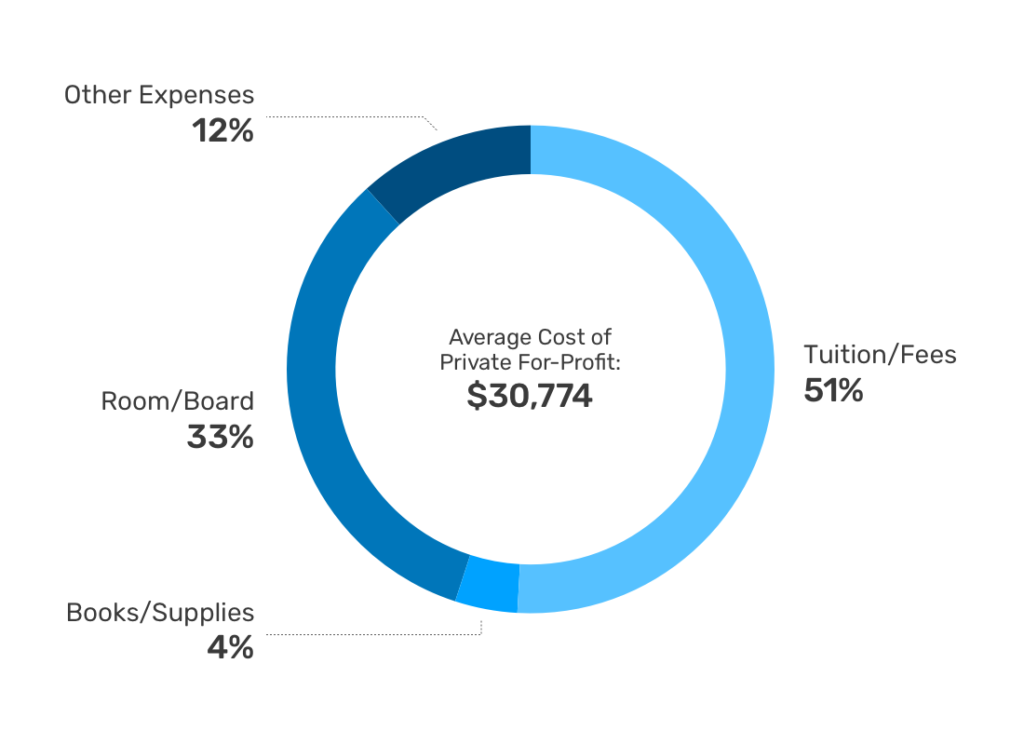
Source: College Tuition Compare
What’s the 2-second bottom line?
If you’re willing to pay, have a low GPA, or served in the military, Private For-Profit colleges may be a good option.
Private Non-Profit
Knowing the Benefits
- Social atmosphere / Mentoring opportunities with professors
- Job fairs, networking opportunity, supportive alumni network
- Wide range of courses to enroll in
- Employer prestige
Keeping it Real about the Drawbacks
- Difficult to transfer credits
- Homogeneous population
- Demanding schedule
Let’s Calculate the Average Total Cost of College Per Year
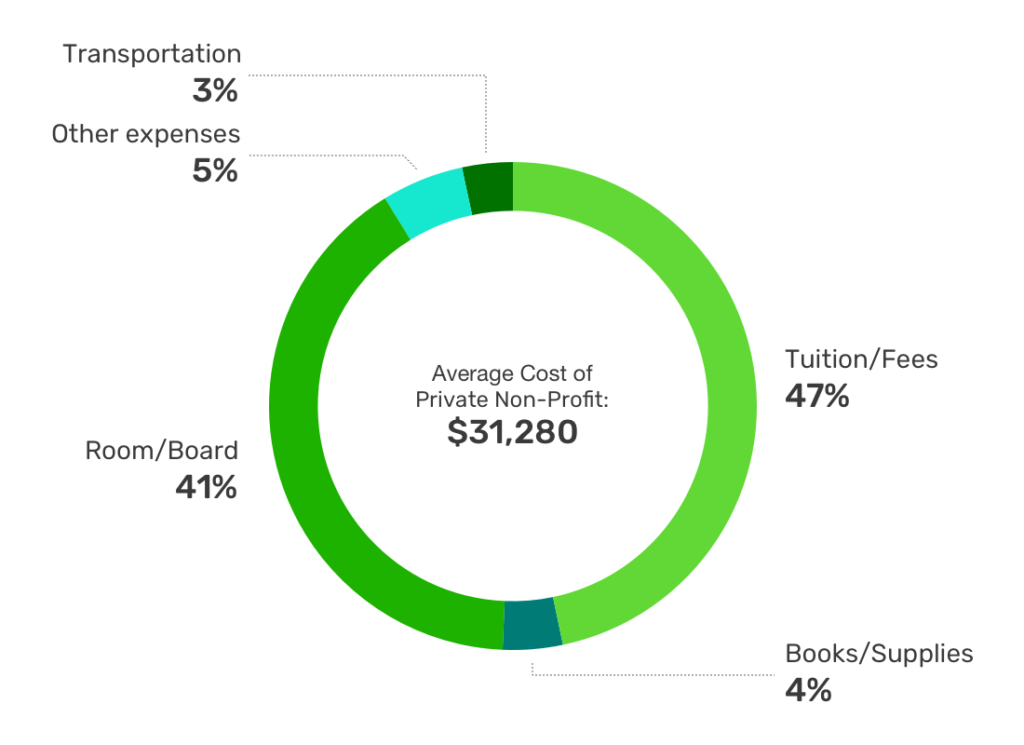
Source: Credible
What’s the 2-second bottom line?
If you want to join a specific program and learn hands-on through discussion with a close-knit group of peers, Private Non-Profit colleges can work well.
Online
Knowing the Benefits
- Study on your own time
- Lower costs
- Builds responsibility and self-discipline
Keeping it Real about the Drawbacks
- Very little peer interaction
- Little personal contact with teacher
- Student must verify quality / accreditation
- Fewer resources than actually going to a campus
Let’s Calculate the Average Total Cost of College Per Year
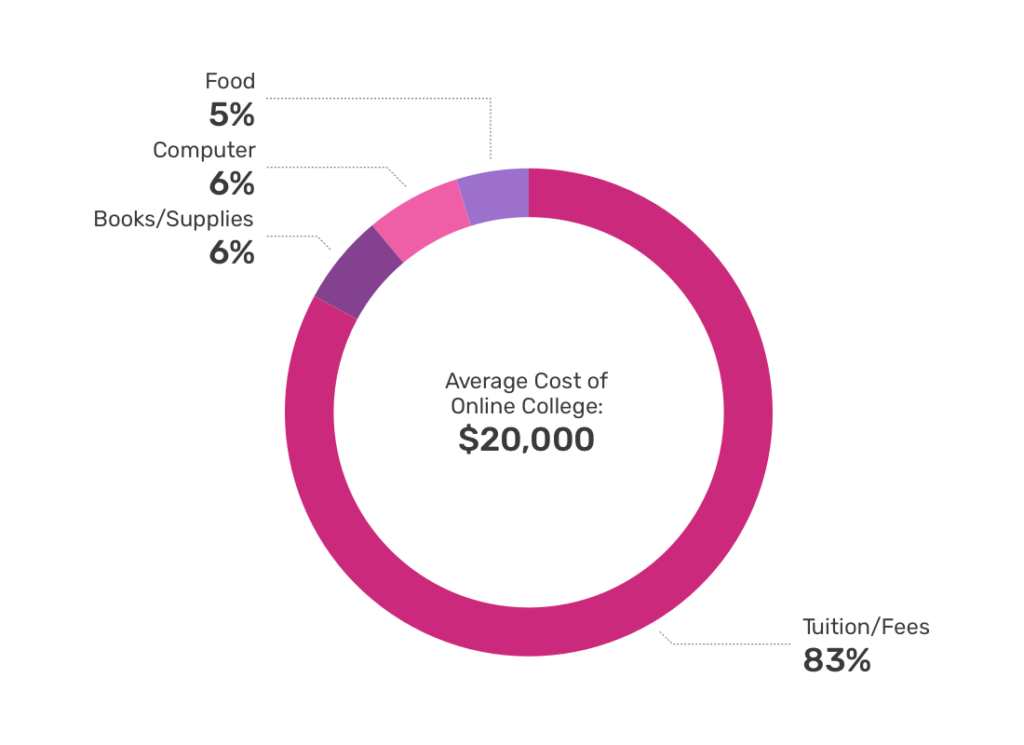
Source: Affordable Colleges Online
What’s the 2-second bottom line?
If flexibility is your number #1 priority, nothing beats working at your own pace online.
On-Campus
Knowing the Benefits
- Vibrant campus life, gym, dining hall
- Very little transportation needed
- Automatic friends and study-buddies (better grades)
Keeping it Real about the Drawbacks
- On-campus amenities significantly boost cost
- Little privacy, individual space comes at a premium
- Moving out during winter and summer breaks
Let’s Calculate the Average Total Cost of College Per Year
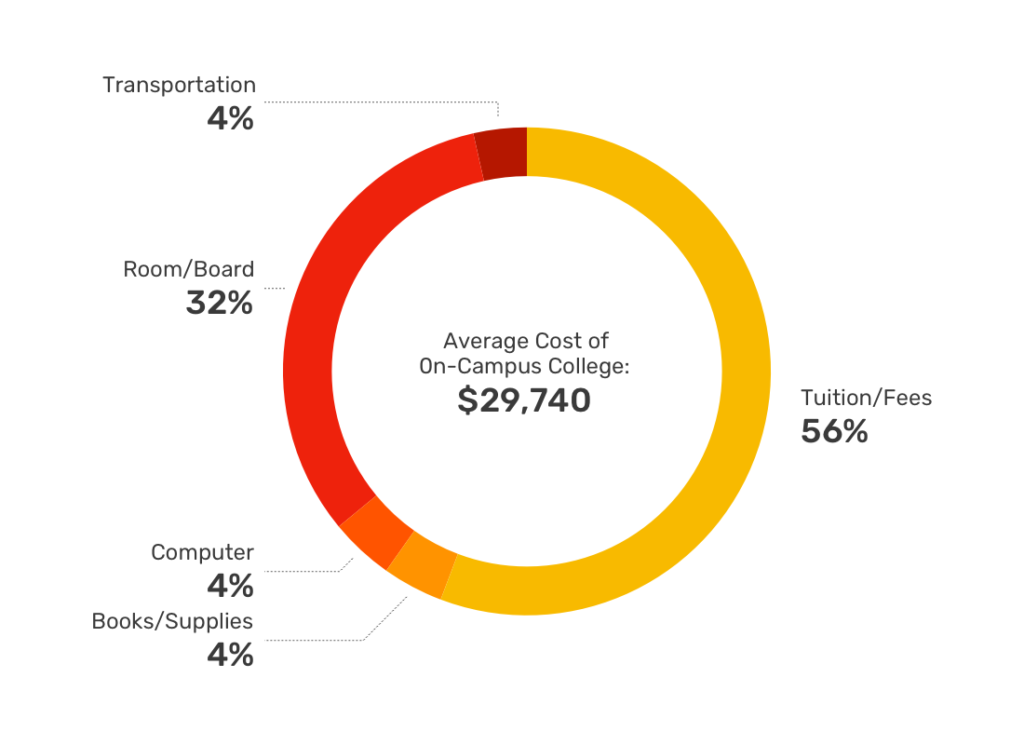
Source: Affordable Colleges Online
What’s the 2-second bottom line?
If networking and making lifelong friends are high-priority options, on-campus colleges are a strong option. Students with liberal arts degrees often land white collar jobs.
Trade Schools
Knowing the Benefits
- Less than ⅓ of new jobs will require a college degree
- Trade school covers immediate job needs for:
- Plumbers
- Electricians
- Welders
- Healthcare technicians
- Can be completed in 6 weeks – 4 years
Keeping it Real about the Drawbacks
- Limited critical thinking classes
- Limited upward career mobility
- Susceptible to changes in job market supply and demand
Let’s Calculate the Average Total Cost of College Per Year
Varies greatly, $3,000 – $15,000
Source: Trade-Schools.net
Here’s the Price per Program
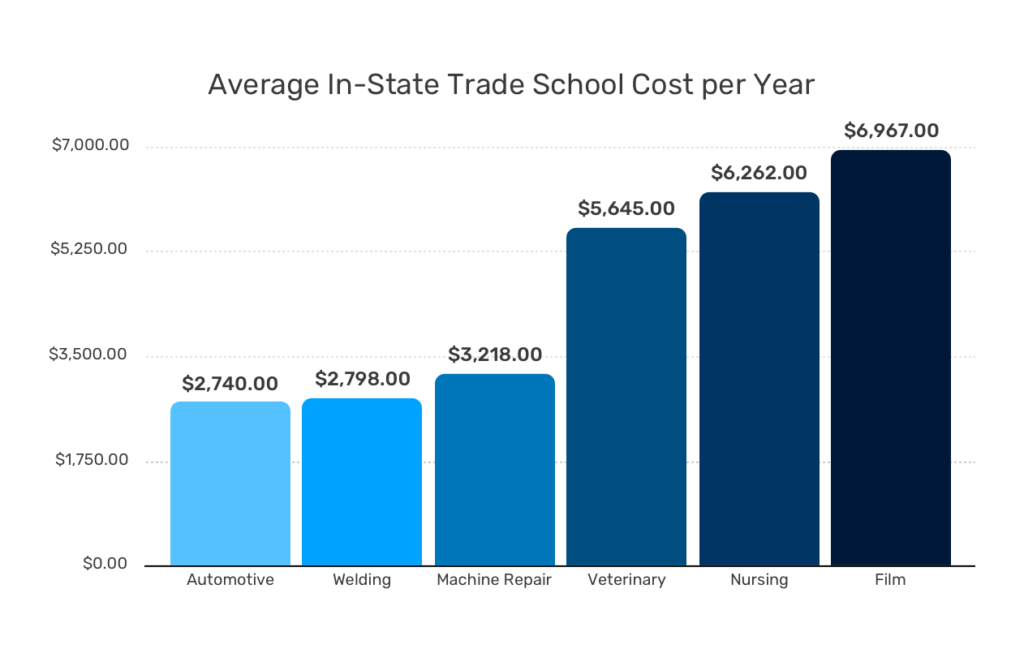
Source: Real Work Matters
What’s the 2-second bottom line?
If avoiding student loans figures high on the priority list and you prefer to live pragmatically, this deserves serious consideration.
Public In-State Tuition (tuition only)
Knowing the Benefits
- Cost-effective tuition
- Predictable education path
- Easy enrollment
Keeping it Real about the Drawbacks
- Going to school with high school classmates
- Limited academic options
- Lack of degree prestige
- Less accessible professors
- Emphasis on learning through lectures
Let’s Calculate the Average College Tuition Price
$10,202
Source: College Board
What’s the 2-second bottom line?
For a traditional (and affordable) college experience, public in-state colleges are the best option.
Public Out-of-State Tuition (tuition only)
Knowing the Benefits
- Possibility of reciprocity programs
- You choose the college experience
- Bigger adventure possibilities
Keeping it Real about the Drawbacks
- Long travel times to return home
- Higher tuition than in-state options
- You will be the outsider
Let’s Calculate the Average College Tuition Price
$25,714
Source: College Board
What’s the 2-second bottom line?
To get away from home and can land some nice scholarships, this option could work well.
Community Colleges
Knowing the Benefits
- Extremely affordable
- Can transfer credits towards bachelor’s degree
- Improve your transcript to get merit scholarships
- Easier work-life balance
- Associates Degrees for short programs
Keeping it Real about the Drawbacks
- Lame campus life
- Limited course offerings
- Lack of networking opportunity
Let’s Calculate the Average Total Cost of College
$3,347
Source: Affordable Colleges
What’s the 2-second bottom line?
To avoid student loans and still finish in 4 years, this powerful option saves major cash.
Bonus Comparison by Region
East Coast
Knowing the Benefits
- 4 distinct seasons
- Cosmopolitan people
- Many historic landmarks
- Many prestigious schools
Keeping it Real about the Drawbacks
- Older and smaller facilities
- Reputation for unfriendliness
- Most expensive tuition
Let’s Calculate the Average College Tuition Price
$24,000
Source: College Calc
West Coast
Knowing the Benefits
- Beautiful weather
- Big and modern facilities
- Close to the beach and mountains
Keeping it Real about the Drawbacks
- Bad traffic and long travel times between cities
- Pervasive homelessness
- High cost of living
Let’s Calculate the Average College Tuition Price
$9,251
Source: College Calc
Midwest
Knowing the Benefits
- Strong hospitality
- Low cost of living
- Easy access to exploring nature
Keeping it Real about the Drawbacks
- Truly brutal winters
- Tons of cheap alcohol
- Lack of cultural development
Let’s Calculate the Average Annual Price (tuition only)
$16,176
Source: College Calc
South
Knowing the Benefits
- Football and sweet tea
- Low cost of living
- Civility and chivalry
Keeping it Real about the Drawbacks
- Hot and humid
- Reputation for racism
Let’s Calculate the Average Annual Price (tuition only)
$8,448
Source: College Calc
Which school type is the best fit? With a better idea of the options, let’s do some googling.
Here’s the search term to use to begin narrowing down some universities:
Best [public/private] [university/trade school/community college] [East coast/West coast/South/Midwest]
・Material comfort to learn in peace・
5 min read & execution
No matter what the college, it’s critical to find a place to call home.
Why is this important?
Being hungry makes it really hard to learn.
If the rent is extremely expensive, that’s going to drain your energy.
Fortunately, there are simple research tips to find out what it’ll be like studying at these schools and how much it’ll cost to learn in peace.
The most important part of your college costs list starts here:
On-campus Living
Room and board often get covered in student loan packages, which make the costs of living more manageable during the semester.
According to the College Board, you’re going to pay $11K-$12K if you stay on campus. However, you will pay more in long-term interest rates for cafeteria dining options and dorms, regardless of whether they are luxurious.
Taking out a loan for room and board, however, is not as bad as having to wonder where your next meal will come from.
To figure out exact room and board costs, use the following search query:
[SCHOOL NAME] + net price calculator

Fill out the form to determine your room and board costs.
This will help compare prices alongside your rent, which will contain fewer expenses, greater independence, and fewer people cooking for you.
Now:
The net price calculator is a POWERFUL tool. In fact, I recommend that you use it for EVERY college you research because it gives a complete price breakdown of your college tuition costs.
However, right now we’re comparing prices for room and board. We’ll cover how scholarships will impact the price you pay at a given school in the last chapter.
Off-campus Rent
The cost of rent depends on:
- Location
- Apartment Quality
- Apartment Size
- Quantity of Roommates
The biggest way to save money starts with having roommates rather than living alone.
If you’re looking for a place quickly, Campuscribz and Craigslist can help.
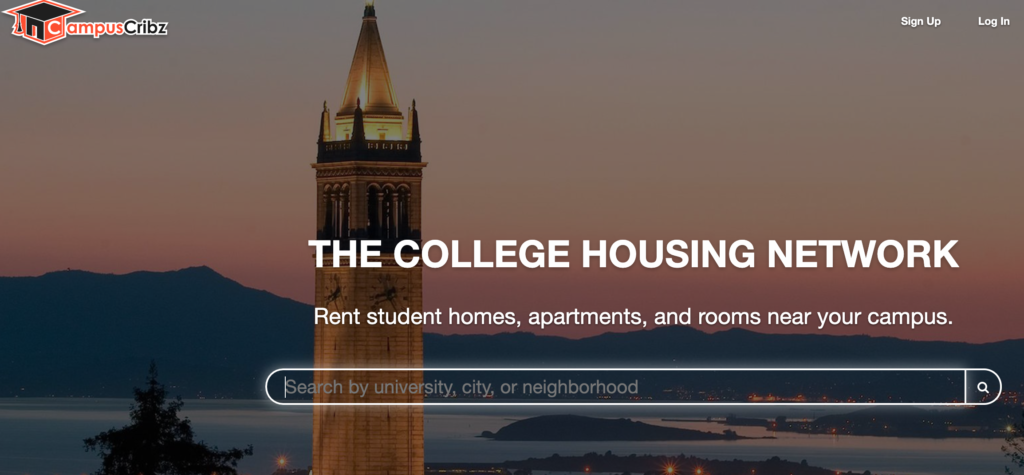
Here are some recommendations for attracting good roommates:
- Aim for roommates who you know and who share your cleaning habits. Clean roommate + messy roommate = misery. Otherwise…
- At the end of the school year, ask the school secretary about other incoming students for the fall semester. They will often take steps to connect potential roommates studying in the same major.
- If posting online, be specific about ideal roommate qualities:
- Cleanliness
- Pet preferences
- Noise tolerance
- Gender preference
- Smoking / alcohol / drugs tolerance
What’s the bottom line? Make sure to get a place with a hot shower, a restful place to sleep, and good food.
・Degree usefulness based on major・
15 min read & execution
Here’s the truth about degree utility:
Not all degrees are created equal. But… certain skillsets that are learned while pursuing a degree will be valuable no matter the career path.
This section contains a clear ranking for the major of your choice compared to the number of jobs available once you graduate.
Let’s dive in!
Find Growth Projections Based on Profession through 2026
In 2016, the US Department of Labor released its report of detailed occupation growth projections.
And the results were staggering!
Sure, there were a few unsurprising results.
Floral designers work in a contracting industry with 6.4% fewer jobs available by 2026.
But a lot of people wouldn’t expect that there will be 7.2% FEWER computer programmers in the same time frame. That’s a net loss of 21.3 million jobs!

![]()
Now:
Even as computer programming becomes less important, the demand for software app developers will skyrocket by 30.7%.
To complete the next section, please download the Department of Labor results here.
Define the Job Market % Growth Rate for Your Major
Here’s how to measure a college major practicality.
- Search for a keyword related to your major. For example, “music”
- For each keyword, write down the following:
- Employment Matrix title
- Percent Change, 2016-26
- Occupational openings, projected 2016-26 annual average
The power of the degree will depend on the demand for the services that are based on the education.
*Keep in mind that that most jobs in the future haven’t been created yet. Technology is changing everything, and the job market is consistently in flux. That means that many skills learned will be helpful even if you end up working outside your major.
If the major involves critical thinking and analysis, strong writing, teamwork, and leadership, then those skills will be valued by any employer.
Consider: what do Alex Trebek, George Soros, and Steve Martin have in common? They were all philosophy majors.
The current US growth rate currently sits at .64% annually and has been trending downward from 1.387% in 1992.
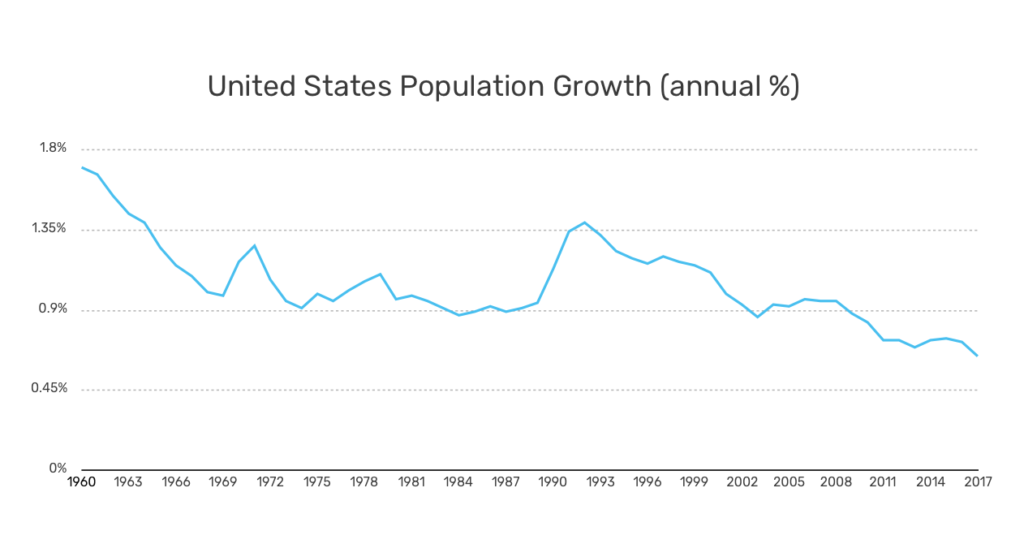
Source: World Bank
What’s the bottom line?
- If the occupation forecast shows less than .64%, avoid it. The industry is contracting.
- If the occupation forecast shows 10% expansion, there’s a growth occupation 🎉
- If the occupation forecast is between .64% and 10%, the demand will depend on the difficulty of becoming qualified to work in that profession.
Why Measuring Your Talent is the Only Thing That Can Save You
This next step requires texting your friends and some self-reflection.
Here’s the deal:
Think back over your past 4 years of high school.
What things did you spend the most time doing?
Check this out:
I’m not asking what you LIKE or ENJOY doing.
Instead, I want you to think about how you ACTUALLY spend your time.
Then message 2-3 of the people who know you best and ask them this question:
“If you could describe how I spend my time in 3 words, what words would you use?”
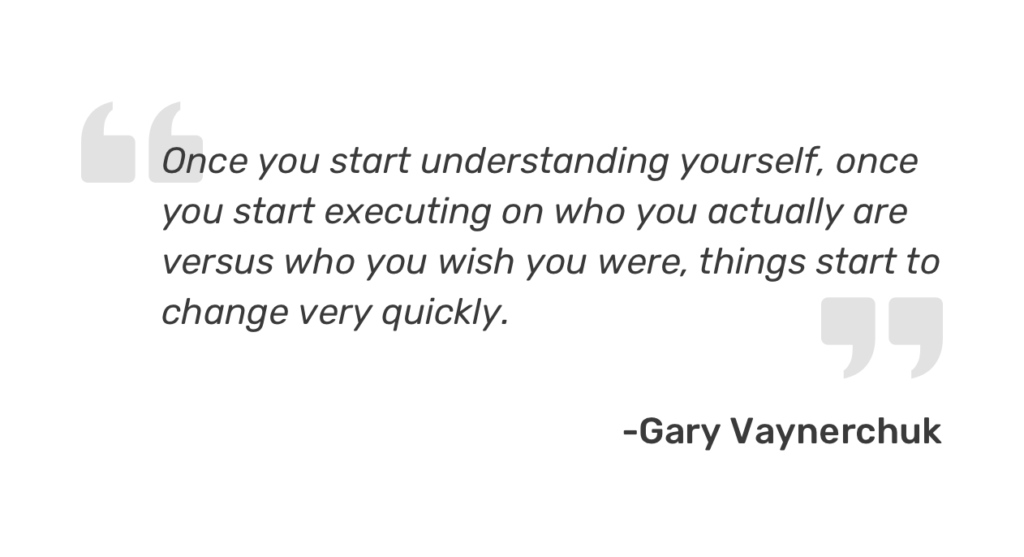
If your time spent doesn’t align with what you want to major in, you should seriously reconsider your major.
And that’s okay. Students change majors all the time. That’s a part of what life is all about: finding yourself.
If your time spent aligns with your chosen major, but you’re headed towards a stagnant/shrinking industry, you might need to be a rock star in your field. Otherwise, consider pivoting to a related field.
If your time spent aligns with what you want to major in and you spend most of your time doing it already, congratulations.
You’re on the right track!
So How Useful is Your Degree, Really?
We’ve covered a lot in this section, but there are really just three points to consider.
- Job demand for your skill
- How you spend your time
- Some parts of education can’t be measured in dollars.
Even if there isn’t high demand for your skill, you’ll do well if you spend a lot of time working on it. This will make you a rock star in your field.
But if the major leads to jobs that have high competition, low job demand, and you don’t spend much free time focusing on it, it would be a good idea to reconsider the major. (Hint: a minor)
・How to track a college’s prestige・
30 min read & execution
Everyone knows that a degree from Harvard will make you more competitive in the job market.
But what about a degree from a community college?
In this chapter, I’m going to show you exactly how to measure the degree prestige of your potential college.
We’ll use two different tools to measure whether the school has a prestigious reputation or a lukewarm reputation that might not impress future employers so much.
Check this out:
Use Google Trends to Determine Public Opinion
Research your School’s Star Power
- Go to trends.google.com and enter the school you’re researching. Make sure to filter the results from 2004-present.
- Look for any spikes in Interest over Time
- Next, do a Google search based on those spikes:
- [UNIVERSITY NAME] + [YEAR / MONTH]
- You can also investigate those spikes by searching Google News
- Click Tools
- Click Recent
- Click Custom range…
- Select the month you wish to search in
Then write down the top results for each spike.
Here’s a quick example with Northwestern University:
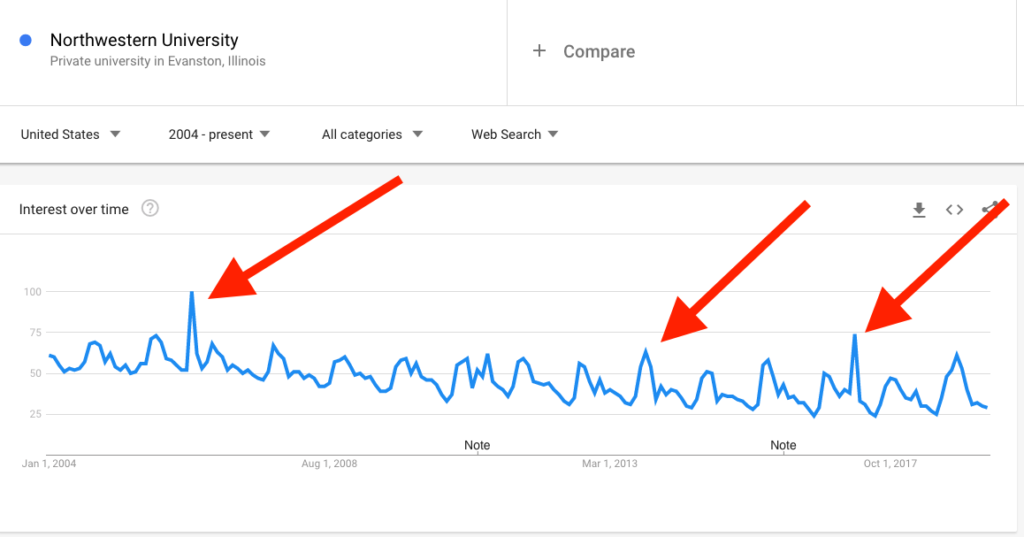
There are three big spikes.
The first was when Senator Barack Obama delivered the Northwestern commencement address in 2006.
The second was where Northwestern considered joining the prestigious Ivy League instead of staying in the Big 10.
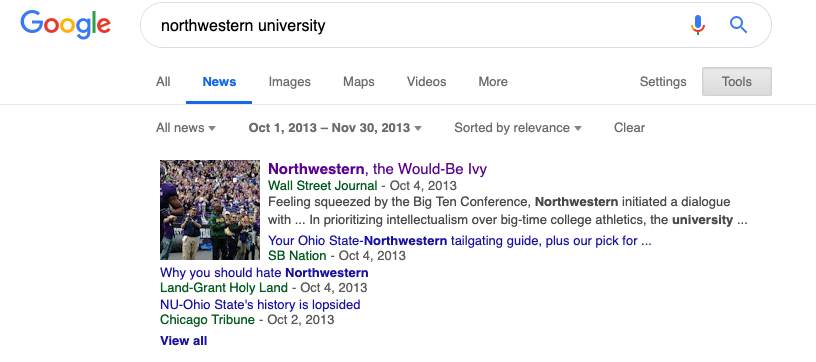
The third spike was in March 2017, when Northwestern won the first round of the NCAA tournament.
How this Score Affects Your Degree Prestige
Now you might be thinking to yourself: what does this have to do with degree prestige?
Measuring PR events will help you understand the most important events your school is known for.
This is the truth about your college degree: perception = reality
When we learn how Google catalogues the school, we get an inside track understanding what people outside of academics think of the school.
This is important since less than 3% of American jobs are actually offered in higher education.
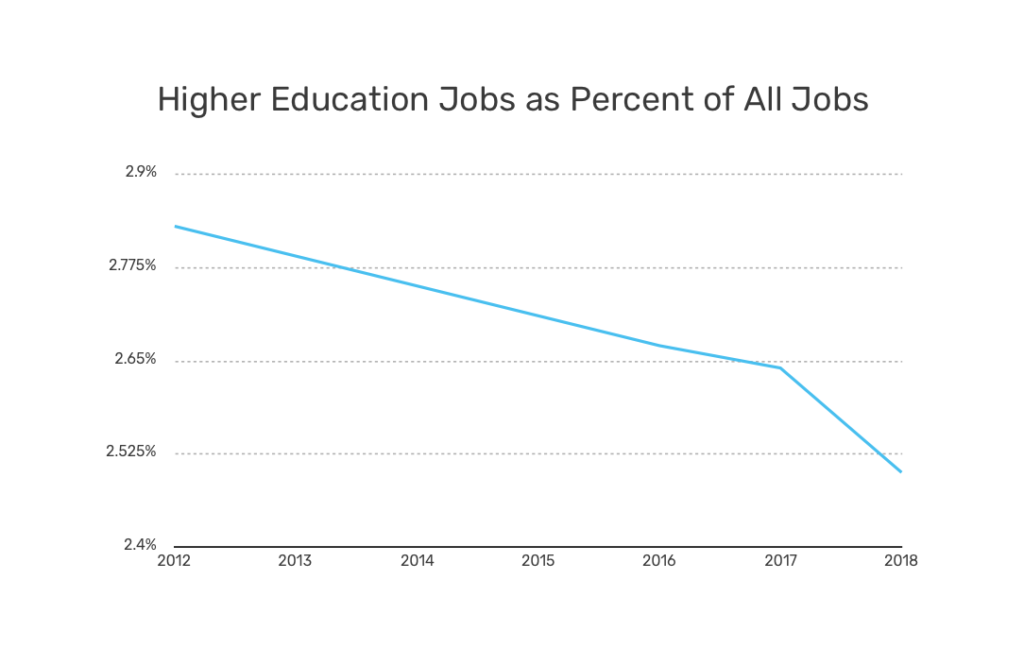
Source: US Department of Labor
Even if you are planning to become a tenured professor for the rest of your life, this approach helps measure a school’s star power.
Check Niche for Academic Quality Scores
Niche.com gathers data from the Department of Education, U.S. Census, and FBI as well as student and parent surveys.
The result is a comprehensive data profile for each school.
Why is this important?
Because it allows direct user input to influence the macro- studies conducted by the US government.
But I’m not going to lie to you..
Academic quality might not matter as much as PR in the eyes of an employer.
BUT Academics standards usually determine how picky a school is for accepting student applicants.
Schools don’t MAKE exceptional students; they CHOOSE exceptional students.
So highly picky schools select students who are pre-qualified for success.
That’s why academics boost the prestige of a school.
Create an Academics Score
Let’s head over to Niche.com and enter the name of the school you are researching.
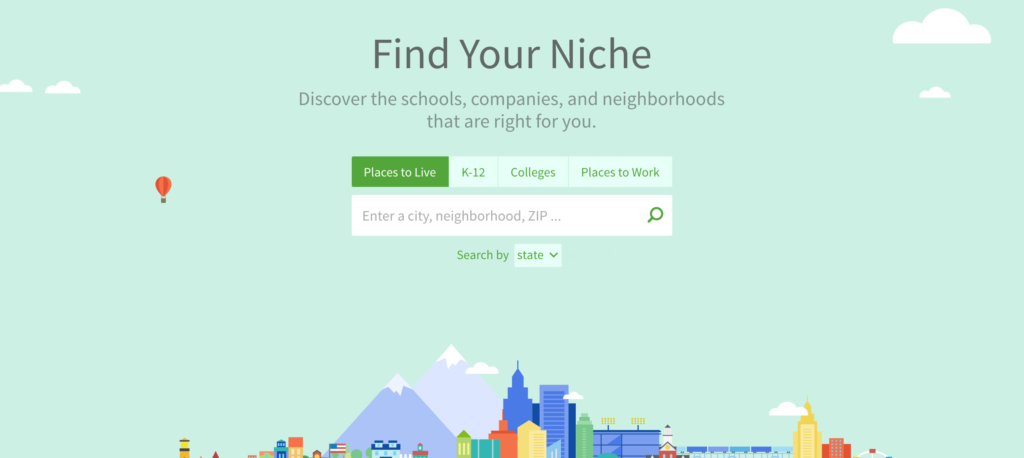
Once you’ve input that, click Academics and write down the grade given by your school.
Anything better than a B- is pretty good.
Interpreting Your College Prestige Results In 2 Minutes
Check out this chart to interpret the results of your findings.
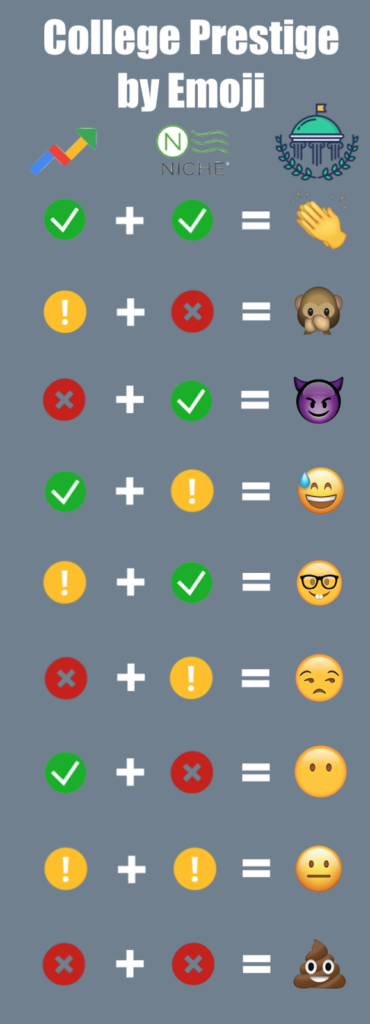
It’s up to you to decide whether a Google trends report is positive, negative, or neutral.
Once you’ve done that, use the emoji table to measure the college’s prestige.
Here’s the deal:
If there’re extremely negative news in the college’s Google Trends report over the past 15 years, this will negatively affect an employer’s view of the college when looking for a job, regardless of high Niche scores.
If the Google Trends report turns up neutral feedback, then the Niche score is an indicator of how much a student will actually learn.
A positive Google Trends report suggests an easier time finding a job. A strong Niche report is the frosting on the cake.
・How program quality compliments your values・
30 min read & execution
The College Board reports that books and school supplies at college cost about $1250 annually.
But how do you know if the actual program at College A fits your needs?
Do they have a strong reputation for helping their students?
Or is it a competitive environment where they expect you to sink or swim?
Only you can decide what works best for YOUR learning needs.
In this chapter, I’m going to teach you a foolproof method for measuring program quality.
Here are some values for you to consider:
- Rigorous academics
- Highly intellectual student body
- Access to internships and work experiences
- Freedom to choose your courses
- Writing center and/or academic assistance and tutors
- Hands on learning
- Learning through solving real world problems
- Type of academic calendar (two semesters? Trimester? 4-1-4?)
- Study abroad options
- Research opportunities
- Personalized academic advising
Okay, now that the want-list is in place, how does a program rate?
Here’s a good starting point:
Use Ratemyprofessor to Scope Out the Department
Most students use ratemyprofessors to pick the best classes once they’re enrolled in school.
And many schools have ratings judging the overall quality of the school.
But VERY FEW students do their homework to check out a department BEFORE they enroll.
Why is this important?
You can enter the program with no illusions about what the environment is like.
There are two steps:
- Read reviews for teachers in the specific department.
- Read the tags associated with the professors.
Teacher behavior starts with the example of the leadership of the department chair.
While there will always be all-star and low-rated teachers, trends with specific tags suggest a department-wide standard.
Here’s a quick example with ratings for Pasadena City College Chemistry classes:
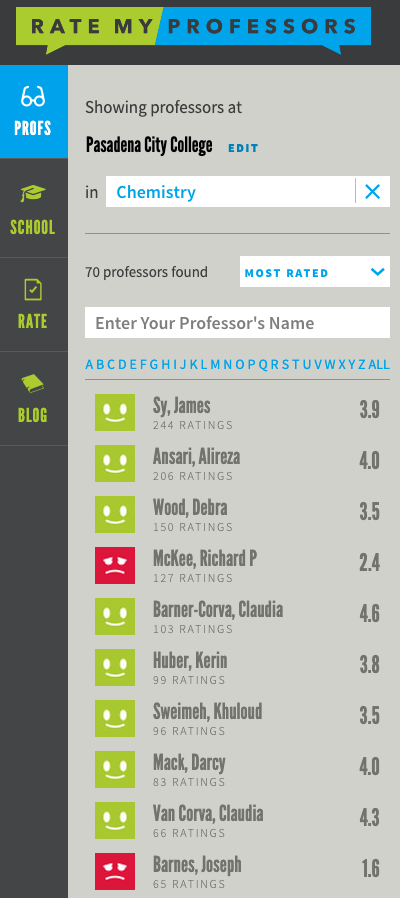
In this case, teachers on this list are known PRIMARILY as tough graders:










It seems like students find most of these teachers are either highly demanding or better off avoiding.
But take a close look at what recent students say about the class.
Are their viewpoints insightful and considered valid by others?

Does their comments reflect an unreasonable or undescriptive point of view?

There is no right or wrong answer here. The only thing that matters is that you do your research.
That way, you’ll know what you’re getting if you decide to enroll.
Get Honest Program Responses with LinkedIn
In this section, I’ll show you exactly how to find CURRENT students to message and give you a script to get real responses.
Let’s dive in.
Find Current College Students to Message
Start by logging in to LinkedIn.
You’ll want to set up an account there if you haven’t already.
This gives you a professional social media profile to search for students.
That’s important since you’re going to need to do some cold messaging.
Once your account is set up, here are the steps for finding students.
- Type the name of the school you are researching into the search bar
- Click the “All Filters” tab at the top of the screen
- Scroll down to Schools and click the name of the school you are researching
- Click apply to refine your search query
Here’s a GIF of the four steps above:
As you can see above, this search technique even works for small community colleges.
Here’s the deal:
Look for students, not professors.
So not all the search results will be relevant.
So take time to verify who you’re contacting before messaging them.
Receive a 39% Higher Response Using this Template
Once you find a student, you can send a message by clicking on their profile name and clicking “Connect.”
LinkedIn might try to make you pay for a subscription if you don’t have a direct connection, but that isn’t necessary.
Just click “More…” on their profile home page and add a note after clicking “Connect” to customize your invitation.

What should you write?
I’m not going to lie to you…
Getting a message from a stranger on LinkedIn isn’t easy.
Template:
You will have 300 characters, and here is exactly how to use them:
Hi, I’m considering applying at [SCHOOL NAME]. I used ratemyprofessors to check out the school. [BRIEFLY DESCRIBE RESULTS]. But college is expensive and takes time, so I want to hear from someone that understands what [SCHOOL NAME] is REALLY like. What’s your take?
Even with this approach, I would only expect around a 20% response rate.
But the feedback and insights will be well worth it!
Here’s a Google Sheets doc you can use to track the students you reach out to on LinkedIn
The best part of these two strategies?
By checking student reviews on ratemyprofessors, you get public knowledge that students wrote for other students.
But asking for an insider’s take on LinkedIn can get a broader picture of the program, plus some things students might not say publicly.
This way, you get both sides of what it’s really like to attend a college.
・Maximize your transfer credits・
40 min read & execution
No matter what school you choose, college tuition inflation ensures there is almost always a cheaper option.
Here’s the deal:
If you know what subjects matter most to your education, you can outsource the less-important classes.
And what exactly are those less-important classes?
Gen Eds.
We all have to take them.
But most students hate them.
I’m going to outline a strategy for you to save a ton of cash and minimize your exposure to general education courses.
The best part is you can crunch the numbers RIGHT NOW with my proven strategy.
And I’m going to break it down for you, step by step.
Find College GenEd Requirements
Finding Gen Ed courses is extremely easy.
Here is the Google search term to use: [SCHOOL NAME] + general education requirements
Categorize Classes Faster with Google Sheets
Once you have your list, use this Google Sheet to make a quick list of all the courses at your college that are considered Gen Ed requirements towards a bachelor’s degree.
Most schools include at least ⅓ of the total 120 hours needed as Gen Ed courses.
Others go up to ½!
Define your Priority Classes to Transfer
Make sure to organize your Gen Ed classes in order from most important to least important.
For example, if I really love math and hate writing, I would put my least favorite courses at the top of the list (English).
Those English courses are my targets to transfer.
Calculate College Tuition Costs with 1 Easy Search Query
Let’s fill in your Google sheet.
To find credit hour cost at the school you want a degree from, use the following search term:
[SCHOOL NAME] + credit hour cost
You’ll probably find a result like this to enter in your sheet:
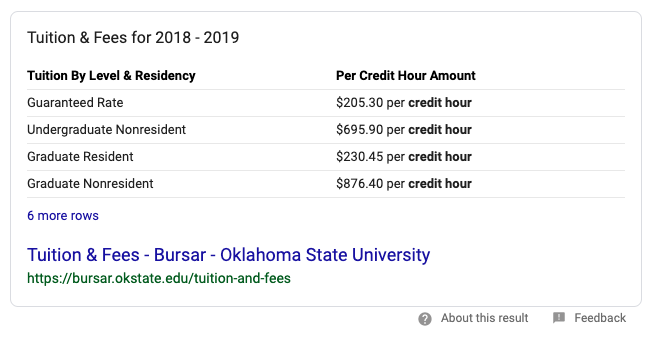
But if you don’t, no worries.
For example, this is the college tuition costs result when I search the credit hour fee at Stanford:

To get a credit hour rate, I divided the tuition fee by 36 (assumes 18 credits per semester).
If you only find a semester rate, I would divide the semester fee by 18.
Then you can enter this figure in Column D (it should be the same for all classes at the same college)
Why is this important?
By calculating your cost per credit hour, you’ll be able to measure the value created by transferring in courses from elsewhere.
Want to figure out where you can transfer courses from?
Keep reading…
Find Replacement Courses
You’ll want to make a profile on Transferology to complete this section.
Their system will ask you what school you attend, so assume you’re already enrolled at the school you’re researching.
Then you can start adding the classes you’d like to transfer (and pay for more affordably).

In this case, I was able to find 559 matches for colleges offering courses that Ohio State University would accept as transfer credit for the two English courses I selected.
I can sort these 559 schools based on location and cost, then fill in the spreadsheet with the results.
BONUS: If you already completed courses for AP credit in high school, you can also confirm if the school you’re interested in would accept these as replacement credit toward your degree.
Just enter your finished courses as replacement courses on the spreadsheet and check to see if your courses will transfer via Transferology.
The best part?
You can immediately see your potential savings on courses you most want to transfer out.
Confirm Replacement Courses with Registrar
Most schools have a transfer credit policy, but Transferology already took care of that for us by giving us an unofficial course audit.
Thank you Internet 🤗
Even better, my research found that many schools including the University of Missouri, Colorado State, and The Ohio State University directly link to Transferology.
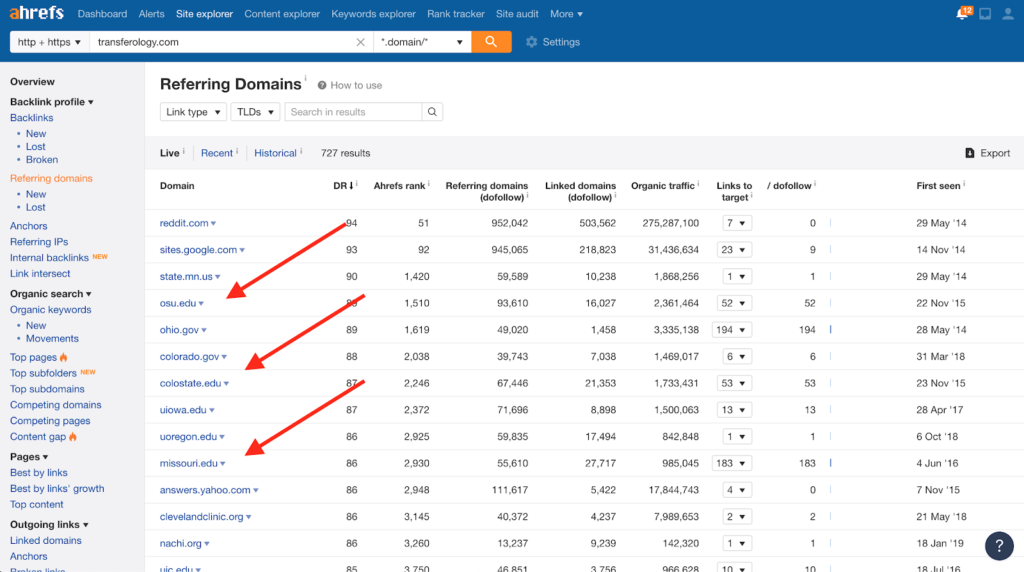
To find out if your school acknowledges Transferology as a legitimate source, use the following Google search query:
site:[YOUR SCHOOL’S WEBSITE] + “transferology”
Either way, I’d recommend directly confirming with the school registrar by sending them a quick email.
Template:
Dear [SCHOOL NAME] Registrar,
I’m getting ready to enroll in college and wanted to confirm which of my completed courses would transfer into [SCHOOL NAME]. Do you consider Transferology as the official authority for transferring courses into [SCHOOL NAME] or is there another process I should consider?
Thank you for your time.
Best,
[YOUR NAME]
This is the truth about transfer credit:
This method works better for a few classes rather than transferring to a new school.
Why?
The opportunity cost of completely transferring to a new school cannot be measured with money. It is harder to make friends as a junior transfer coming into a new environment. Also, opportunities for finding a professor to mentor you will be lower as a transfer student than if you spend all 4 years at the same college.
But with this method, you have learned how to save cash. You know how to determine which colleges will make replacement credit as simple as possible.
Finally, we’ve covered which courses will transfer the easiest and likely save you $5,000-$10,000 in tuition costs from more expensive colleges. And that’s important for building financial freedom!
・What campus entertainment is really like・
20 min read & execution
The College Board reports that students typically spend about $3,000 annually on travel and entertainment ($2,730 at private colleges, $3,270 at public colleges).
But we all have different priorities going to college no matter how we choose to have fun.
Why is this important?
College is about building skills that help others, and who you know influences where you can go, what you do, and who you’ll become.
A big part of college is about being open to new experiences and new people.
How to meet new friends is always the big question.
In this section I’ll show you how most students socialize on any given campus.
So let’s dive into some extremely simple ways for measuring campus entertainment options.
You already know that Instagram is all about showing off the perfect and the cool lifestyle we all aspire to.
We can also use it to dig into what the exterior of your school actually looks like.
To do this I recommend using the Keyword Tool . This free tool will supercharge your search process to find the right tags and influencers that live on the campus you’re researching.
This is a freemium product, but the unpaid version provides more than enough information to get you started.
Here are the steps for using Keyword Tool:
- Search for these keyword ideas with the Hashtags tab:
- Specific school
- School hashtag
- City name
- Theme [school name] + [subject]

- Browse popular account with the people tab:
- Search the People tab
- Click top posts for popular hashtags
- Focus on people in your intended major if possible

- Take the Keyword Tool results from steps 1 and 2 to browse through Instagram.
Examine the details of the photos. Are there lots of fraternities? Are students at sporting events? What locations turn up?
For example, the University of Missouri values sport like Track and Field (but already looks forward to football), celebrates graduation achievements, and loves Shakespeare’s pizza.

But if you dig deeper you’ll realize that Mizzou is also a sorority town.

The results will show you what you can expect to encounter should you enroll there.
But there’s more than just sports and clubs. You can really get to see the culture of the campus, and the surrounding community.
Look up the following terms and see what you see:
- Campus vibe
- Do students live on campus
- Football, basketball, baseball, track and field
- Greek life
- Politically and environmentally active student body
- Intramurals
- Your favorite food
- Dorms
- LGBTQ
- Multiculturalism
- Clubs
- Leadership
- Islam, Christianity, etc.
Did you know Mizzou has its own brand of ice cream? Tiger Stripe is their home flavor.
Yelp
Yelp can give you a more objective idea about what it’s like to attend school there.
The power of Yelp is that the information comes from a completely different audience.
For example, Instagram would say Mizzou is all about Greek life.
Is this true?
Yelp can help you decide.
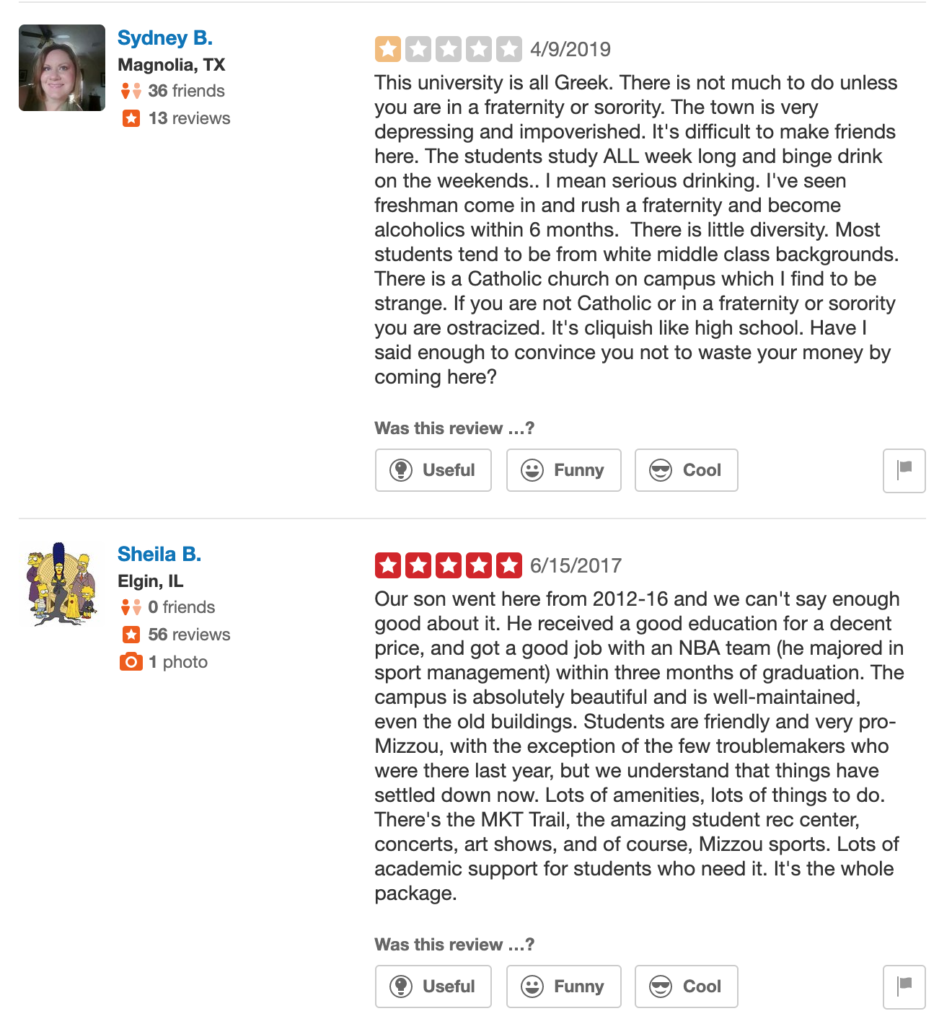
The platform tends to get reviews from recent graduates and parents instead of students, but the results speak to a larger truth about the school.
By reading the reviews, you’ll know what to expect should you choose to attend.
For both Instagram and Yelp, the lack of information can be just as informative as actual user results.
If you don’t find much using these tactics, it’s possible that the school you’re researching hasn’t made a huge impression on its students.
・How to calculate scholarship impact・
15 min read & execution
Scholarships are available at the national, state, and local levels, and you’ll want to start with a strategy for filling out the FAFSA. Our friends at The Scholarship System can help with that. But how to maximize your quantity of scholarships received?
Here are 6 strategies to boost your scholarship exposure:
-
Know what makes you special
Then emphasize those qualities and focus on scholarships that promote those qualities. Some ideas:
-
- Awards you won
- Ethnicity / heritage
- African-Americans
- Hispanics
- Latinos
- First in family to attend school
- Hobbies you have
- Languages you know
- Leadership experience
- LGBTQ orientation
- Military veteran
- Music / theater participation
- Religious participation
- Social media presence
- Sports participation
- Unique travel experience
- Volunteer experience
-
Search for specific schools you want to attend
-
- Use this search query:
- [UNIVERSITY NAME] + merit scholarships
- Here are the typical standards for getting this kind of scholarship:
- Rules-based qualification using ACT / SAT scores and GPA
- High payouts
- Easy to qualify for
- Use this search query:
-
Target big brand scholarships
-
- For a comprehensive list see Harvard grad Francesca Fulciniti’s article. Here are some popular options:
- Questbridge
- Coca-Cola
- National Merit
- Gates Millennium
- Foot Locker Scholar Athletes
- Dell Scholars
- Lower likelihood to win
- High payouts ($1000s-$10000s)
- Read the details to decide if applying makes sense for you
- For a comprehensive list see Harvard grad Francesca Fulciniti’s article. Here are some popular options:
-
Focus on small local scholarships
-
- Use these search queries:
- [STATE] scholarships
- [CITY] scholarships
- [NEIGHBORHOOD] scholarships
- [SCHOOL DISTRICT] scholarships
- [COMMUNITY COLLEGE] scholarships
- Higher likelihood to win
- Low payouts ($100s-$1000s)
- Use these search queries:
-
Access popular scholarship resources and advice
-
- Myscholly
- $2.99 monthly
- It’s an app
- No spam
- Scholarships.com
- Free search
- Higher possibility of spam
- To avoid spam, here are some typical offers to IGNORE:
- You are preselected, but you didn’t apply
- Your scholarships come with upfront fees
- You’re requested to pre-pay taxes on scholarship
- Your scholarship will be delivered via check
- Myscholly
Now:
Let’s do the math.
How much of your scholarships received will contribute to tuition at the school you’re considering?
You’ll want to add the numbers, but also consider if the scholarships will be recurring beyond freshman year.
Once you’ve added the figures, you can accurately calculate the impact of your scholarship at any school in the country.
・Conclusion・
So that’s my ultimate guide to considering college tuition costs.
Research complete!
If you’ve completed this guide, you know what to REALLY expect when enrolling at any college in the country.
Most importantly, you know that the most expensive college is the one that doesn’t fit well with your budget and priorities.
But I want to turn it over to you: what did you think about this guide? Or maybe there’s something I missed.
Let me know by leaving a comment below.
And that’s it for my College Guidebook. Congratulations. You made it to the end!

9 comments found
Michelle McAnaney, The College Spy
I’m pleased to see local scholarships mentioned in your guide. I typically advise students to focus on these because they are less competitive than national scholarships. One thing students should be aware of is that colleges sometimes reduce the amount of financial aid given by the amount of the scholarship. Therefore, time spent fills it out scholarship applications is wasted. Students should ask the colleges they are considering how they handle outside scholarship awards.
StudyGate
Excellent point Michelle, thanks for that important insight!
Taliaferro Alexander
Thanks for the net price calculator link. I never thought to looking at the correlation of tuition cost of a school in regards to it’s location. Your drawbacks of going to school in the separate areas of the U.S are spot on (I have traveled a decent amount, and generally noticed the same characteristics). Honestly, I have never seen so much QUALITY higher education information packed into one blog. I will definitely use this as a reference tool for all of my acquaintances who have children headed to college. Thanks for improving my perspective!
StudyGate
Each region (and school) has its benefits and drawbacks, for sure. And that’s the point. There are some very gifted students who would be miserable at Harvard.
Elli
This is quite possibly the most comprehensive and useful guide for students exploring their college career path that I’ve ever come across. So first and foremost, thank you for creating it (I actually forwarded the link to several teacher friends of mine halfway through because I knew they would want to share it with their students). I thought from the title that this would center solely on the financial side of college (calculating costs, finding scholarships, etc), but you also encourage readers to dig deeper and explore what their college prospects have to offer them. Excellent guide!
StudyGate
Thanks Elli!
Jasmine Hewitt
This is quite literally the most in-depth guide I have ever read on measuring college tuition costs!
StudyGate
Great!
Sabrina Cortes
You have a wealth of information here! I like that you not only break down tuition by colleges but by region as well. One thing that stood out to me is that you encourage students to dig deeper to understand themselves so that they can pursue the career of their dreams. Many students don’t know what they want to do, or they have a few careers that they’re interested in. I’d encourage them to take a couple of courses to see what peaks their interest. This way, they learn more about themselves which is essential to ensuring a successful college experience. Excellent piece!